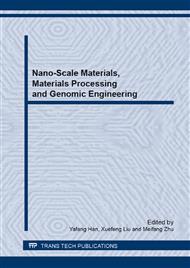[1]
H.M. Meng, L. Guo, H. Zhang, D.B. Sun, H.Y. Yu, Z.S. Fan, X.D. Wang, C.N. Patent ZL201010578846.5 (2011).
Google Scholar
[2]
H. Zhang, H.M. Meng, L. Guo, H.Y. Yu, D.B. Sun, New energy-saving and green method of preparation of EMD in using oxygen cathode, China's Manganese Industry 31 (2013) 27-30.
Google Scholar
[3]
J. Wang, R.F. Savinell, Simulation studies on the fuel electrode of a H2O2 polymer electrolyte fuel cel, Electrochim. Acta 37 (1992) 2737-2745.
DOI: 10.1016/0013-4686(92)85201-u
Google Scholar
[4]
K. Otsuka, I.Yamanaka, One step synthesis of hydrogen peroxide through fuel cell reaction, Electrochim. Acta 35 (1990) 319-322.
DOI: 10.1016/0013-4686(90)87004-l
Google Scholar
[5]
I. Moussallem, J. Jorissen, U. Kunz, S. Pinnow, T. Turek, Chlor-alkali electrolysis with oxygen depolarized cathodes: history, present status and future prospects, J. Appl. Electrochem. 38 (2008) 1177-1194.
DOI: 10.1007/s10800-008-9556-9
Google Scholar
[6]
B. Boye, D.M. Morième Brillas, E.A. oxidation, Anodic oxidation, electro-Fenton and photoelectro-Fenton treatments of 2,4,5-trichlorophenoxyacetic acid, J. Electroanal. Chem. 557 (2003) 135-146.
DOI: 10.1016/s0022-0728(03)00366-8
Google Scholar
[7]
Y.L. Ma, S.J. Sun, Study on the manufacture of Pt-C/PTFE gas-diffusion electrodes, Journal of Qinghai Normal University (Natural Science) 4 (1996) 47-49.
Google Scholar
[8]
H. Dong, H.B. Yu, X. Wang, Q.X. Zhou, J.L. Feng, A novel structure of scalable air-cathode without Nafion and Pt by rolling activated carbon and PTFE as catalyst layer in microbial fuel cells, Water Res. 46 (2012) 5777-5787.
DOI: 10.1016/j.watres.2012.08.005
Google Scholar
[9]
S.J. Lee, S.I. Pyun, Effect of annealing temperature on mixed proton transport and charge transfer-controlled oxygen reduction in gas diffusion electrode, Electrochim. Acta 52 (2007) 6525-6533.
DOI: 10.1016/j.electacta.2007.04.081
Google Scholar
[10]
H. Chhina, S. Campbell S, O. Kesler, High surface area synthesis, electrochemical activity, and stability of tungsten carbide supported Pt during oxygen reduction in proton exchange membrane fuel cells, J. Power Sources 179 (2008) 50-59.
DOI: 10.1016/j.jpowsour.2007.12.105
Google Scholar
[11]
H. Chhina, S.Campbell S, O. Kesler, Thermal and electrochemical stability of tungsten carbide catalyst supports, J. Power Sources 164 (2007) 431-440.
DOI: 10.1016/j.jpowsour.2006.11.003
Google Scholar
[12]
M. Nagai, M. Yoshida, H. Tominaga, Reprint of "Tungsten and nickel tungsten carbides as anode electrocatalysts", Electrochim. Acta 53 (2007) 1030-1036.
DOI: 10.1016/j.electacta.2007.09.036
Google Scholar
[13]
C.A. Ma, Y. Huang, Y.H. Zhu, Z.Y. Chen, W.F. Lin, Preparation and characterization of Pt/WC catalyst for oxygen reduction at gas-diffusion electrode, Journal of Chemical Industry and Engineering (China) 60 (2009) 2633-2639.
Google Scholar
[14]
H.F. Xu, J.H. Dong, X.L. Hou, Facilitated effect of Ag to oxygen transportation in PEM fuel cell air cathodes, J. Electrochem. 12 (2006) 434-438.
Google Scholar
[15]
K. Hayashi K, N. Furuya, Preparation of gas diffusion electrodes by electrophoretic deposition, J. Electrochem. Soc. 151 (2004), A354-A357.
DOI: 10.1149/1.1641034
Google Scholar
[16]
Z.Z. Tan, G.G. Mei, W.J. Li, in: W.S. Zhang (Eds.), Metallurgy of manganese, Central south university press, 2004, volume 7, chapter 2, pp.441-448.
Google Scholar
[17]
X.M. Liu, X.G. Zhang, Studies on ultrafine MnO2 as electrode material of electrochemical capacitor, Chemical Research and Application, 15 (2003) 515-517.
Google Scholar
[18]
S.W. Cao, Z.Y. Deng, W.L. Zhang, High performance EMD for mercury-free alkline Zn/MnO2 battery, Chinses Battery Industry 7 (2002) 179-182.
Google Scholar
[19]
H. Dohle, J. Mergel, D. Stolten, Heat and power management of a direct-methanol-fuel-cell (DMFC) system, J. Power Sources111 (2002) 268-282.
DOI: 10.1016/s0378-7753(02)00339-7
Google Scholar


